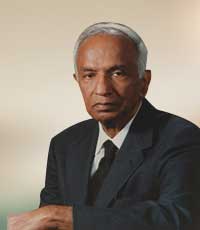Birth Anniversary Special : Diamond of Astrophysics Subrahmanyan Chandrasekhar
The great indian astrophysicist and distinguished fellow of Royal Society of London , Subramaniyam Chandrashekhar was born on 19th October 1910 in Lahore (now in Pakistan) . He was one of ten children born to Sita Balakrishnan and Chandrasekhara Subrahmanya Ayyar.
In 1918, he moved to Chennai where he attended the Hindu high school finishing his secondary school education with honours. He then joined the presidency College, there taking his bachelor of science degree in physics with honours.
His first scientific paper "Compton scattering and the New Statistics" was published in the proceedings of the royal society in 1928. On the basis of this paper he was accepted as a research student by R.H. Fowler at the University of Cambridge. He also studied for one year in Copenhagen at the Institut for Teoretisk Fysik prior to receiving his Ph.D. from Cambridge in 1933.
On the voyage to England he developed the "Theory of White Dwarf Stars" showing that a star of mass greater than 1.44 times the mass of the sun could not become a white dwarf. This limit is now known as Chandrasekhar limit. He showed that there is a maximum mass which can be supported against gravity by pressure made up of electrons and atomic nuclei. The value of this limit is about 1.44 times a solar mass. This was derived by Chandrasekhar in 1930, when he was a student. The Chandrasekhar Limit plays a crucial role in understanding the stellar evolution. If the mass of a star exceeded this limit, the star would not become a white dwarf. It would continue to collapse under the extreme pressure of gravitational forces. The formulation of the Chandrasekhar Limit led to the discovery of neutron stars and black holes. It may be noted that stars are stable, that is they do not collapse because internal pressures (due to the thermal motion of the atomic nuclei and electrons and also the pressure of the radiation generated by nuclear reactions) balance gravity. However, for every star a time will come when nuclear reactions will cease and that means there will be no internal pressure to match the gravitational pull. Depending on the mass there are three possible final stages of a star – white dwarf, neutron star and black hole. His research explored nearly all branches of theoretical astrophysics. Chandrasekhar was awarded (jointly with the nuclear astro_physicist W.A. Fowler) the Nobel Prize in Physics in 1983.
Seven periods of his life :
There have been seven periods in subramanyam chandrshekhar's life. They are briefly :
- Stellar structure, including the theory of white dwarfs (1929-39);
- Stellar dynamics, including the theory of Brownian motions (1938-43);
- The theory of radiative transfer, the theory of the illumination and the polarization of sunlit sky, the theories of planetary and stellar atmosphere, and the quantum theory of negative ion of hydrogen (1943-50);
- Hydrodynamic and hydromagnetic stability (1952-61);
- The equilibrium and the stability of ellipsoidal figures of equilibrium (1961-68);
- The general theory of relativity and relativistic astrophysics (1962-71); and
- The mathematical theory of black holes (1974-83)”.
He was one of the first scientists to couple the study of physics with the study of astronomy. Chandra proved that there was an upper limit to the mass of a white dwarf. This limit, known as the Chandra limit, showed that stars more massive than the Sun would explode or form black holes as they died. Chandra also developed theories on star atmospheres, black holes, the illumination of the sunlit sky, star structures and star mass.
He obtained his doctorate in 1933. Subsequently, he was awarded the Prize Fellowship in Trinity College, Cambridge.
In 1937 he became a research associate at Chicago University. He stayed at this university throughout his career , becoming the Morton D Hall distinguished professor in astronomy and astrophysics in 1952.
He became US citizen in 1958. He was elected fellow of the Royal Society of London and received the society's Royal Medal. He also received the US National Medal of Science in 1966. He passed away on 21 August 1995.







